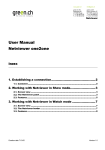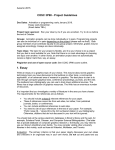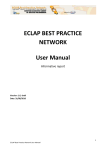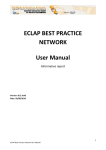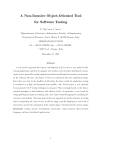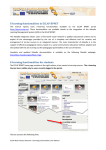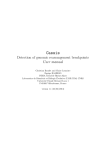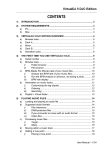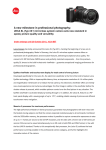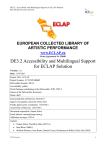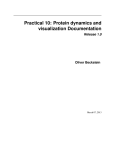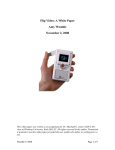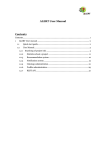Download MyStoryPlayer for ECLAP Non Linear Story Modeling and
Transcript
MyStoryPlayer for ECLAP Non Linear Story Modeling and Navigation Tools based on Semantic Annotations User Manual Pierfrancesco Bellini, Paolo Nesi, Marco Serena Distributed Systems and Internet Technology Lab, Department of Systems and Informatics University of Florence, Via S. Marta 3, Florence, 50139 Italy [email protected] , [email protected] , [email protected] http://www.disit.dsi.unifi.it www.eclap.eu MyStoryPlayer allows users to be the central part in fruition of multimedia objects relating them, and offers new solutions for educational and infotainment purposes. As we are in a performing arts environment, let us show you some examples of application of such a tool. For example: if a teacher wants to prepare a lesson for his students, synchronizing slides and video in the same environment, or adding some pictures or audios examples that can explain better the concepts of his lesson, with MyStoryPlayer he can do that! If a user is owner of many multimedia objects of the same event, for example taken from different views, and want to relate each other and play them synchronously and in parallel on the same player, with MyStoryPlayer he can do that! If a user want to connect events each other following some particular aspects like the characters, the dancers, the theatres, the music, the moviemakers, ecc, creating a package of multimedia related objects connected by a leitmotif and visible in interactive way, with MyStoryPlayer he can do that! The innovative part of MyStoryPlayer lies in the fact that no difference between media and the user’s annotation exists, because both categories are referred to multimedia objects and they are temporally connected. Moreover, as annotations are audiovisual, the possibility of both multiple contemporary views and multiple choices on what to watch is provided to the user, thus giving him a sensation of freedom in building his personal narrative experience. Every time the user chooses a video to be played, rectangles appear just below the temporal line to indicate the length of annotations according to the duration of the main playing video. When the main video is running, another video or more media (which can be video, audio or images) start to play by level with a rectangle aside from the main video. Before to explain in detail all the necessary steps to make an annotation on ECLAP, it is better to focus on what a user is going to do when he/she annotates a media through MyStoryPlayer. An annotation (or Media Relationship) on MyStoryPlayer is composed mainly by two elements: • A text description, as in other annotation tools, • A link between media, related through a time relation. For example a user can relate a part of a video that lasts one minute, with a slice of another video that lasts 30 seconds. In the MyStoryPlayer interface, these two media will be reproduced synchronously according to their temporal lines. This kind of relation allows the user to connect two media that in his opinion are related by topics or events, characters in the scene, music, moviemaker, or they are different visuals of the same event and he want to see them synchronously. Many reasons could be valid to relate some parts or entire media each other. It’s up to the user the choice on what to annotate, MyStoryPlayer gives him freedom to be a producer of his history. Once an user has annotated a media, the interface will allow him to view in parallel all the media related each other, just as in the example below. Figure 1: MyStoryPlayer How to add a Relationship to a media On ECLAP portal and in other contexts there are several videos that are suitable for some new kind of annotations. There are many videos coming from the same event and divided in sequential/synchronized parts that can be collected and annotated with the purpose of building a playable structure in which the user can navigate and view them in a interactive and synchronized manner on MyStoryPlayer facility. In figure 2, an example of Toni Servillo videos which are present in the portal is show. Fig 2: example of structure annotation with Tony Servillo lab videos There are many videos from a theatrical laboratory of Toni Servillo, Dario Fo and Paolo Rossi that took place at CTA Rome (UNIROMA1). This laboratory lasted some days and it has been recorded from three camera in the room (right side, frontal and left side) and the video of each day is divided in many parts. It is possible to connect through annotations all these video, creating a structure ordered by day, by sequence and synchronized by point of view. The result is a multi-views vision for each part of the sequence, as you can see in the figure 3. Fig 3: view of synchronization of Toni Servillo videos on MyStoryPlayer In the above Figure 2, two arrows are present, indicating the entry point in the non linear structure. If a user enters in the point indicated by the blue arrow (by accessing to the MyStoryPlayer icon 3 on that video ), the story will begin from there. While entering from another icon could lead you to start from the red arrow, see the story from there . For users the first step to access the Add Relationship tool and define a new relationship is to select the “Add Relationship” from an audiovisual content in any ECLAP list of content, including content in results of queries, content featured, last posted, top rated, etc., see Figure 4. Figure 4: Add media relationship from the content lists on ECLAP. This can be performed from the action panel below the preview of media, or below the player during the reproduction of media. Therefore, once decided to add a relationship, the Media Relationship tool (depicted in Figure 5) is proposed, always referring to the content selected (in the same manner other content can be added, while the first is considered to be the master). The interface provides information to the user, and allows deciding which kind of relationship to be chosen: One2One, Synchronous, Sequential, or Explosive. The ECLAP portal has a large amount of content, users may use the search facilities of ECLAP to identify the content to be related and aggregated according to those models. a) b) Figure 5: Creation of assisted relationships among media. The user may select the kind of relationship to be exploited: One2One, Synchronous, Sequential, or Explosive. For example, when selecting ‘synchronize’, a list of suggested media to be related is proposed (by clicking on the check box related to items, the medium is added to the top list). Then saving the selection implies creating all reciprocal relationships. The list of suggested media is produced by a similarity algorithm based on metadata similarity. Different algorithms are used in different cases, and the user may filter the results for different media: only video, audio, images, etc Moreover, for the production of Synchronous and Sequential relationships, due to the large amount of content, the Add Relationship tool on ECLAP portal provides suggestions according to the: (i) metadata of the master content selected, (ii) type of relationship model chosen by the user, (iii) type of media requested (video, audio images). a) b) Figure 6: Sequential Annotation. In a) it is shown a list of suggested item to relate to the first, based on similar title. b) it is shown the list of chosen items put in sequence. The Add Relationship tool provides a different behaviour according to the type of relationship as described in the following. One2One: in this case, the involved media can be two (among video, audio and image), and the time segments should be chosen directly on a proper player, independently. The ECLAP audiovisual player allows defining the start and end positions on their time line for audio and video, while for images the duration is requested (see Figure 7). Figure 7: Editing time segment along the temporal line of a video by positioning the cursor in the selected time instant and clicking on the corresponding marker points for start [- and for end -]. Explosion: In MyStoryPlayer domain, a different kind of executable relationship among audiovisual is defined as the Audio Visual Explosion. This case can be regarded as a special case of the previous scenarios where the master audiovisual segment had a zero duration, that means to have an audiovisual annotation attached to a single time instant. In this case, the involved audiovisual can be only two, the user has to identify only a single point on the master audiovisual, and a segment in the second. The ECLAP audio visual player allows defining those points with simple clicks on the time line. The execution of this audiovisual relationship among Video 1 (V1) and Video 2 (V2) allows expanding the execution time line of V1 with the identified segment of V2; just returning to the execution of V1 once the V2 segment execution is completed. This model is equivalent to the action of opening a parenthesis where some aspects can be recalled, and then closing it to restart from the point where the parenthesis had been put. This kind of relationship can be used to explain a single time instant with an expanded scenario; to show possible cut scenes, to stress possible variants, to insert comments by the director, to explode a single time instant with a more complex scenario , etc. Synchronous: in this case, the number of media can be very high since for N media N2-N relationships are produced. They can be selected from those suggested or from the other ECLAP content lists. The pool of selected content is automatically related one another and reciprocally, thus avoiding to replicate the same relationships with the same time segments and text. Also in this case it is possible to set media segments to relate them, instead of the entire media, starting from the beginning of each media source. As in the One2One relation, it is possible to set the start and the end position out of the player interface and create reciprocal annotations just for those selected parts. If no segment is chosen, the entire medium is taken by default. In Figure 3b, the three chosen media identify the first part of the first day, taken from three different points of view. When creating these relationships, the system will create 6 reciprocal relationships relating each item to the others, which means that all the media can be regarded as masters. Sequential: in this case, the number of media can be very high. This kind of annotations is made to satisfy the need to put in sequence media concerning the same event, or to give a sequential order to media according to a timeline or a narrative path. They can be selected from those suggested or from the other ECLAP content lists. A system of suggestions has been developed, which helps users in finding similar objects with similar titles and having the sequence of the event already encoded (for example, title_1/3, title_2/3..). When the relationship is created, the pool of selected content is automatically related one another according to the order such content is presented with in the Add Relationship tool. The user may move up and down the selected content by using drag and drop mechanisms. Also in this case, the system avoids replicating the same relationship among the same media with the same time segments and text. The default value sees the media aligned since the end of each item, when automatically the player switches to the following media. By clicking on Save button, the relationship(s) are added to a content; thus, the number of relationships for that content is increased and displayed in the content lists on ECLAP via small icons such as 3 , which means that 3 relationships are available for that content.








